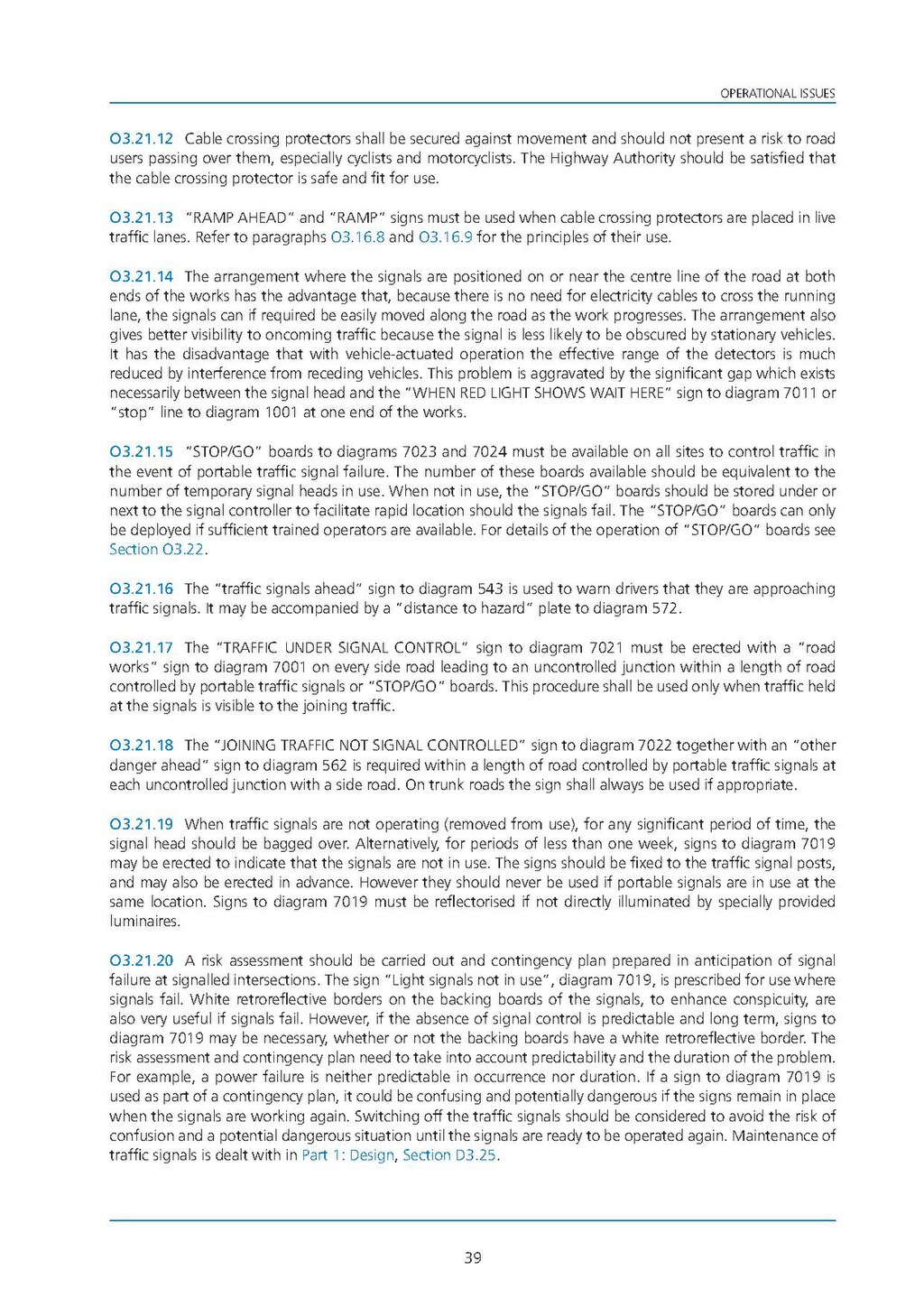O3.21.12 Cable crossing protectors shall be secured against movement and should not present a risk to road users passing over them, especially cyclists and motorcyclists. The Highway Authority should be satisfied that the cable crossing protector is safe and fit for use.
O3.21.13 "RAMP AHEAD" and "RAMP" signs must be used when cable crossing protectors are placed in live traffic lanes. Refer to paragraphs O3.16.8 and O3.16.9 for the principles of their use.
O3.21.14 The arrangement where the signals are positioned on or near the centre line of the road at both ends of the works has the advantage that, because there is no need for electricity cables to cross the running lane, the signals can if required be easily moved along the road as the work progresses. The arrangement also gives better visibility to oncoming traffic because the signal is less likely to be obscured by stationary vehicles. It has the disadvantage that with vehicle-actuated operation the effective range of the detectors is much reduced by interference from receding vehicles. This problem is aggravated by the significant gap which exists necessarily between the signal head and the "WHEN RED LIGHT SHOWS WAIT HERE" sign to diagram 7011 or "stop" line to diagram 1001 at one end of the works.
O3.21.15 "STOP/GO" boards to diagrams 7023 and 7024 must be available on all sites to control traffic in the event of portable traffic signal failure. The number of these boards available should be equivalent to the number of temporary signal heads in use. When not in use, the "STOP/GO" boards should be stored under or next to the signal controller to facilitate rapid location should the signals fail. The "STOP/GO" boards can only be deployed if sufficient trained operators are available. For details of the operation of "STOP/GO" boards see Section O3.22.
O3.21.16 The "traffic signals ahead" sign to diagram 543 is used to warn drivers that they are approaching traffic signals. It may be accompanied by a “distance to hazard” plate to diagram 572.
O3.21.17 The “TRAFFIC UNDER SIGNAL CONTROL” sign to diagram 7021 must be erected with a "road works" sign to diagram 7001 on every side road leading to an uncontrolled junction within a length of road controlled by portable traffic signals or "STOP/GO" boards. This procedure shall be used only when traffic held at the signals is visible to the joining traffic.
O3.21.18 The "JOINING TRAFFIC NOT SIGNAL CONTROLLED" sign to diagram 7022 together with an "other danger ahead" sign to diagram 562 is required within a length of road controlled by portable traffic signals at each uncontrolled junction with a side road. On trunk roads the sign shall always be used if appropriate.
O3.21.19 When traffic signals are not operating (removed from use), for any significant period of time, the signal head should be bagged over. Alternatively, for periods of less than one week, signs to diagram 7019 may be erected to indicate that the signals are not in use. The signs should be fixed to the traffic signal posts, and may also be erected in advance. However they should never be used if portable signals are in use at the same location. Signs to diagram 7019 must be reflectorised if not directly illuminated by specially provided luminaires.
O3.21.20 A risk assessment should be carried out and contingency plan prepared in anticipation of signal failure at signalled intersections. The sign "Light signals not in use", diagram 7019, is prescribed for use where signals fail. White retroreflective borders on the backing boards of the signals, to enhance conspicuity, are also very useful if signals fail. However, if the absence of signal control is predictable and long term, signs to diagram 7019 may be necessary, whether or not the backing boards have a white retroreflective border. The risk assessment and contingency plan need to take into account predictability and the duration of the problem. For example, a power failure is neither predictable in occurrence nor duration. If a sign to diagram 7019 is used as part of a contingency plan, it could be confusing and potentially dangerous if the signs remain in place when the signals are working again. Switching off the traffic signals should be considered to avoid the risk of confusion and a potential dangerous situation until the signals are ready to be operated again. Maintenance of traffic signals is dealt with in Part 1: Design, Section D3.25.
39
